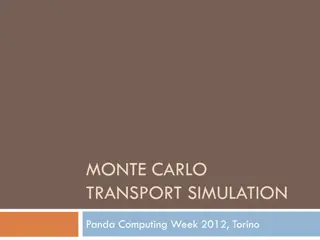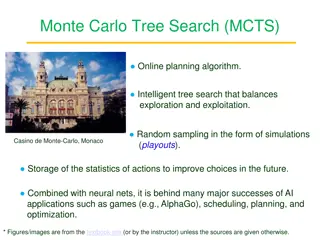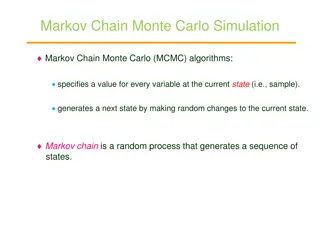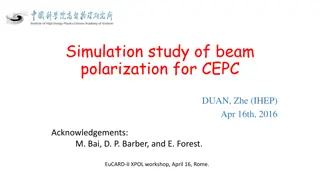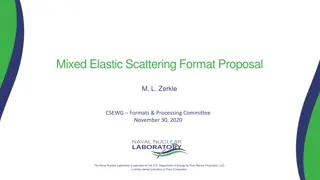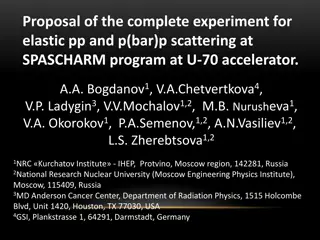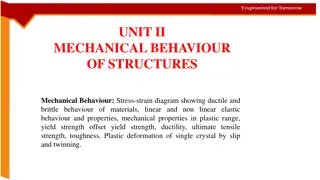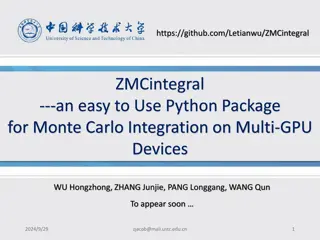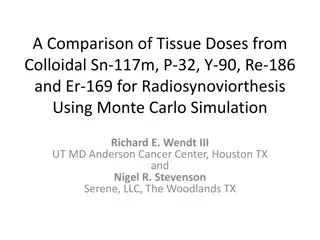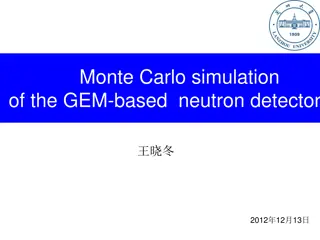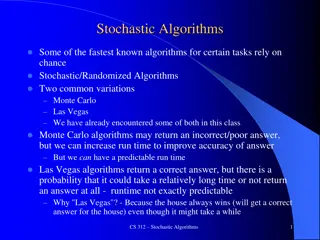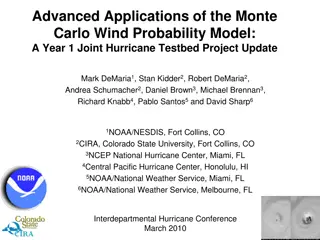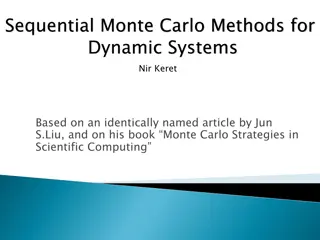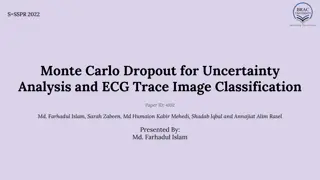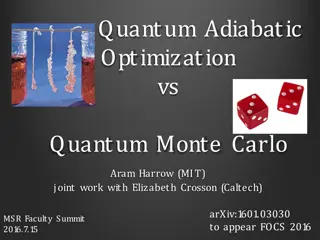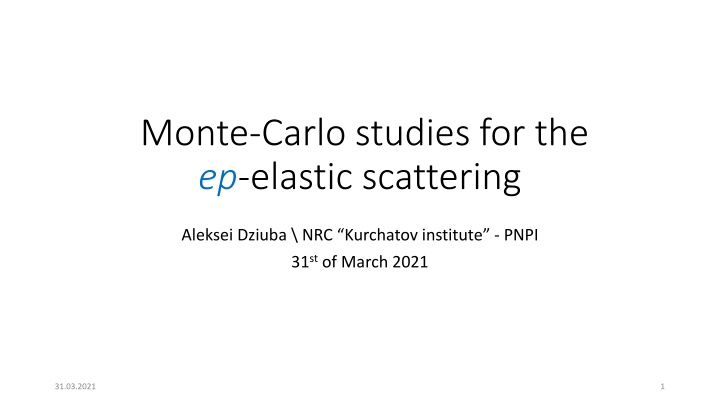
Monte-Carlo Studies for EP Elastic Scattering
This presentation covers Monte-Carlo studies for EP elastic scattering conducted by Aleksei Dziuba at NRC Kurchatov Institute - PNPI. It explores simulation software strategies, goals, manpower, current status, new developments, ESEPP generator configuration, beam smearing, electronic signal and noise simulations, drift velocity experiments, Z-position measurements, recoil ranges, detector conditions for Monte-Carlo simulations, software status, and event generators like ESEPP. The talk discusses the software chain, team members involved, and enhancements made to the software stack. Additionally, it delves into the handmade production generation for inelastic processes and correlation analysis to reject inelastic background.
Download Presentation

Please find below an Image/Link to download the presentation.
The content on the website is provided AS IS for your information and personal use only. It may not be sold, licensed, or shared on other websites without obtaining consent from the author. If you encounter any issues during the download, it is possible that the publisher has removed the file from their server.
You are allowed to download the files provided on this website for personal or commercial use, subject to the condition that they are used lawfully. All files are the property of their respective owners.
The content on the website is provided AS IS for your information and personal use only. It may not be sold, licensed, or shared on other websites without obtaining consent from the author.
E N D
Presentation Transcript
Monte-Carlo studies for the ep-elastic scattering Aleksei Dziuba \ NRC Kurchatov institute - PNPI 31stof March 2021 31.03.2021 1
Outline Simulation software strategy Goal \ Simulation chain \ Manpower Current status What s new? ESEPP generator config Beam smearing at the exit window (already mentioned by Peter Kravtsov) Electronic signal https://github.com/aleksha/electronic-signal Electronic noise https://github.com/aleksha/electronic-noise Drift velocity experiment Drift in electric field https://github.com/aleksha/pres-electric-field Z-position measurement (angular dependence, power of MVA methods) Recoil ranges for calibration https://github.com/nuramatov/esepp/ 31.03.2021 2
Run / detector conditions for MC Beam model Time distribution for incoming electrons; mean beam frequency fb; 2D beam spatial distribution Gausx( bx, bx) Gausx( by, by) ? Any beam halo? Beam direction distribution Gausp( p , p ) Uniformp (- , ) ? Geant-4 (detector model) provides ionization TPC time resolution model Drift velocities Wd1, Wd2; Recombination(rhit, fb); (x,y)-smearing(rhit, fb) Accepting due to not clean gas. Signal formation (during grid-anode drift) TDC parameters: Nch, tch; ti TDC channel Energy to TDC response CTDC; Noise spectrum Time-pulse function Dirac(ti) Some distribution(t,ti,Tj) These conditions must be included into Monte-Carlo to have is as closer to the data as possible to mimic operation conditions as a function of (beam)time Goal: MC can be analyzed as DATA 31.03.2021 3
Software status All important parts were investigated New studies (done in 2020-03 2021-03) will be presented in the main part of the talk Software chain of isolated tools, but not a one program Manpower: Prof. Vorobyev (ideas, coordination, review) Aleksei Dziuba (with a large input of ideas and settings from PNPI teams) Arsen Nuramatov (bachelor-year student of SPbSU) 31.03.2021 4
Generators 31.03.2021 5
There will be no loss in central (not sensitive) part of CSC Event generators ESEPP https://github.com/gramolin/esepp to account radiative corrections We updated a software stack (conda) and now there is a way not to build it with a dependencies-hell (use pres-mc) A nice config-file (not interactive) https://github.com/nuramatov/esepp/ NEW Handmade production generation for inelastic (there are more realistic approximation in PRad paper) Correlation between Tpand electron and proton angle is powerful tool to reject inelastic background 31.03.2021 6
Beam smearing 31.03.2021 7
Beam smearing by main detector CSC = Cathode Strip Chamber For scattered electrons Y H2, 20 atm Ar + CH4 20 atm TPC volume Anode Sci, 10 mm Count electrons Mylar, 20 m Cathode Be window Ti Z Grid 720 MeV electron beam CSC Ionization chamber (for total beam current control) Beam position chambers (for feedback to MAMI) 400 mm Mylar, 50 m Sci + W wire? Be (?) windows 720 MeV electron beam Calibration purposes 31.03.2021 8
Beam smearing at the exit window 5 bars 20 bars 31.03.2021 9
Induced current (during grid-anode drift) 31.03.2021 10
Anode current calculation Problem: signal is created during grid-anode drift. Additional smearing to a signal shaping This method is suggested by Alexander Dobrovolsky (PNPI) dobrovolsky_av@pnpi.nrcki.ru Based on Grinberg s textbook Simulation tool uses CERN.ROOT framework https://root.cern.ch/ Electronic signal tool: https://github.com/aleksha/electronic-signal 11
Charge between two infinite planes From potential one can go to the induced charge using Gauss theorem L distance between planes r radial distance from a charge h distance between plane and charge q electron charge (q=-1) pp.113 12
The method in a nutshell Create a map of induced charge on rings with fixed width for an electron which is moving perpendicular to anode at r=0. Calculate induced charge and induced current (as a derivative of the induced charge) with defined anode structure for an electron in point (x,y) using an overlap of the map and anodes. Find which of anode is fired, using the largest integral of current. Rescale currents for each of anodes with a common factor, which is evaluated to set the current integral for the fired anode to unity. 13
Electronic signal tool: https://github.com/aleksha/electronic-signal Induced charge and current for x=12mm, y=18mm x=12mm, y=18mm 2ndring (width 40 mm) 1string (width 40 mm) Central pad (r=10 mm) Example of a tool result Agreement with the expected behavior Need to speed it up As well as integration into a software chain Numerical errors (too close r order of h) 14 Note that it isn t zero!
Modification of the response functions Many thanks to Alexander Dobrovolsky, who pointed me on the problem! Signal appears when electron reach anode Current is assumed to be constant, while electron drifting between Grid and Anode Current during Grid-Anode drift Zero time time, when electron is on the grid LGridAnode= 10 mm; W2= 7,5 mm/ s 15
Drift velocity measurements 31.03.2021 16
Calibration of drift velocities titanium Triggering from incoming beam electron. Time between beam and TPC response is known (with a precision discussed today). MAMI has excellent beam. The ionization-anode distance is known with 0,1 mm precision. 17
All pads Central pad is a circle with 1 cm radius Others are half-rings with 4 cm width Numbering as on sketch 14 Beam 16 3 X 5 1 7 0 8 2 13 4 9 15 6 12 10 1stanode 11 16thanode 18
Longitudinal diffusion of electrons Z= 0,008 LTrackGrid [ Z] = [LTrackGrid] = cm Parametrization by German Korolev (private communication via Alexey Vorobyev) Smear Z-position for each ionization electron by a Gaussian function with Z. LTrackGrid= 25 cm 10000 of beam electrons (a part of spectrum around the peak is presented) Peak maximum as a time-point estimator Noise OFF No diffusion With longitudinal diffusion 19
With diffusion Without diffusion A scatter around a smooth curve indicates the accuracy of the estimate! A bias for the maximum position estimator is on nanosecond-scale. Good enough! 20
Increase diffusion parameter by factor 4 8-9 ns shift at 250 mm 21
Electronic noise simulation + influence on a drift velocity measurement 31.03.2021 22
See more details https://github.com/aleksha/G4-Models/tree/master/Data/Noise Further studies of noise + simulation Now it s fast! (factor 1000 wrt 1stversion) Thanks to Arsen Nuramatov Noise in data (baseline corrected) Generated noise 1. Obtain distribution for real and imaginary part of frequency spectra using Fourier transformation; 2. Fit these distributions using two gaussian hypotheses; 3. Generate random spectrum out of these distributions; 4. Use inverse Fourier transformation to obtain spectrum of generated events. Electronic noise tool https://github.com/aleksha/electronic-noise 23
Maximum (peak position) shift due to noise Peak is placed to the random location of cumulative noise spectrum Shift of maximum for signal + noise (blue) wrt. pure signal (green) Some fit examples shift due to noise Noise ON 24
Distribution for shifts for 100k events 100 random places for signal peak at the noise spectrum. Signal shape at the peak region and cumulative noise spectra are same, but position is different! RMS for maximum with peak position fitting procedure 6,1 ns 25
Electric field uniformity 31.03.2021 26
Electric field uniformity + drift of electrons Electric field calculations are done by Kuzma Ivshin using COMSOL package. Electron is drifted in the electric field. Its track is a series of the steps, defined by a step parameter. A typical step size (of 0.1 mm) is order of magnitude less than a spatial grid size for the electric field (5 mm). A direction for the step is chosen according to a unit vector parallel to an electric field direction. Electric field components in a beginning of a step are inferred by an interpolation procedure (tri-linear interpolation). Tool to calculate shifts https://github.com/aleksha/pres-electric-field 31.03.2021 27
Electric field uniformity + drift of electrons No radial shift if Exand Eyare set to zero Some radial shift for the full field map The direction of this is to the center of TPC! There is strong Rinand Zindependence Tool https://github.com/aleksha/pres-electric-field Further development is needed (interpolation-based shift procedure) 31.03.2021 28
Issue with a Z-positioning 31.03.2021 29
A problem of Z-positioning PRES experiment requires a Q2scale calibration, which will be done using a measurement of an angle of the scattered electron. Measurement will be done with a first layer of multiwire and Z coordinate of a scattering point measured by a TPC (X and Y assumed to be zero due to the perfect MAMI beam). Z is measured on the 1stanode ring by finding of a stable timestamp point from the FADC signal. Central pad has twice worser resolution due it s small size (relatively higher electronic noise) and due to the beam noise. Signal shapes depends on a scattering angle of the proton (T fixed) 30
Time point measurement (~40 ns resolution) Start point, measured using front intersection with a baseline T = 5 MeV Noise ON 1string Maximum distribution (pol2-fit) Time e- reach anode Time when e- reach grid 1333 ns 31
The problem T = 5 MeV Angle wrt. Y-axis Noise OFF 1string Cumulative spectra RMS = 40 ns Peak position Uncertainty for a single event 1string 0 deg wrt. Y 600 ns 5 deg Strong dependence 32
Note, that y-scale are different, but integrals are the same! Pure electron signal (a cross check) Electrons arrive at grid Idea by Alexander Inglessi Induced current 0 deg. 0 deg. w/o diffusion with diffusion 2,5 deg. 2,5 deg. 5 deg. 5 deg. 5 deg Signal projection 0,087*40mm = 3,48 mm Signal length 870 ns 33
Pure electron signal (a cross check) Electrons arrive at grid Idea by Alexander Inglessi Drift + Electronic response function 0 deg. 0 deg. 2,5 deg. 2,5 deg. 5 deg. 5 deg. 5 deg Signal projection 0,087*40mm = 3,48 mm Signal length 870 ns 34
Correction by TPC information Recoil angle can be measured by TPC Correction on a measured angle 0,3-0,4 mm resolution of simple algorithm, when offset is estimated from the measured angle Multivariate analysis (MLP) can make 0,2 mm resolution accessible (next slides) mean : 5.31285 rms : 0.999505 Angle measiured by 1stand 2ndrings MC truth 5 deg. 35
MVA regression as an estimator Uniform pdf ZTRUE= (190, 210) mm ThetaTRUE= (0, 6) deg TTRUE= (4,5, 5,5) MeV Standard ROOT::TMVA example Multi Layer Perceptron (MLP) Boosted decision tree (BDT) Linear discriminant analysis (LD) Z or polar angle as target variable 800 events for training / 150 for test To be compared with 0,3-0,4 mm resolution o simple algorithm, when offset is estimated from the measured angle 22.07.2020 36
First MVA results (Z as a target) ===================================================== MVA Method: <Bias> <Bias_T> RMS RMS_T ===================================================== 9 variables (start, peak, end) from central anode and first two rings ----------------------------------------------------- MLP : -0.0246 -0.0299 0.166 0.140 LD : -0.0310 -0.0366 0.174 0.146 BDT : -0.0177 -0.0126 0.229 0.191 Indicated by "_T" are the corresponding "truncated" quantities obtained when removing events deviating more than 2sigma from average. To be compared with 0,3-0,4 mm resolution of simple algorithm, when offset is estimated from the measured angle Optimization is required 22.07.2020 37
First MVA results (angle as a target) ===================================================== MVA Method: <Bias> <Bias_T> RMS RMS_T ===================================================== 9 variables (start, peak, end) from central anode and first two rings ----------------------------------------------------- MLP : -0.00304 0.0196 0.538 LD : 0.0274 0.0215 0.539 0.451 0.435 To be compared with ~1,0 deg resolution (see slide 4) Optimization is required Conclusion: we have to use full power of MVA in our analysis 22.07.2020 38
Real life (well its ESEPP) Electron angle, deg ESEPP configuration: Photon cut 0,5 MeV Point-like proton E=720 MeV Lepton cut 5 deg. Maximon & Tjon Full other rad.calc 10 MeV Estimates at the previous slide is done for this point 5 MeV 2 MeV Recoil angle, deg 39 https://github.com/gramolin/esepp
ESEPP Recoil energy, MeV Quite close to linear One should not expect large quadratic effects in Z-scale calibration Three problems in the middle: 1. Radiative processes (aka corrections) can create recoils with higher energy which stop between anodes 2. Same but via in-elastic processes (with pions) 3. A certain signal detection limit can produce bias Recoil angle, deg 40
Range measurement 31.03.2021 41
Energy by stop between anodes Between 2 and 3 Between 4 and 5 Between 3 and 4 Between 2 and 3 Between 2 and 3 7000ev 42 Gen.Cut on TR Gen.Cut on TR
+/- 100 keV range, 7000 events Reconstructed TR True TR 43
Stopped on edge between 2ndand 3rdrings True TR Reconstructed TR Asymmetry Find zero crossing True = 4.9797 +- 0.0008 MeV Rec. = 4.9753 +- 0.0010 MeV 44 True Rec. = -4.4 keV (-4.3 )
Same energy, same angles, but bias due to Zrec TPC MWPC P (far) P (close) Z 700 mm 0 mm 400 mm e l e Time bias 600 ns +2,4 mm to a true position wrt. anode 0,3 mrad (resolution 0,04 mrad) 0,7 mrad (resolution 0,10 mrad) to measure in MC Identical events with =5 deg. (87 mrad) Far: Close: Bias in reconstructed Difference order of 0,4 mrad 45
Z-dependent bias in reconstructed angle Mean value of the bias of reconstructed (TPC-MWPC based) with respect to a true one depends on Z Bias correction put peak into ZTRUE Still some bias, which is higher for higher Z, as expected Why?!! Misalignment? Center of TPC Close to anode (Far) Close to cathode (Close) Mean +/- Error of Mean 46
Yes! This was a mistype in code misalignment Everything fine but requires MC calibration constant! 47
Find tune parameter from best fit by constant For each shift calculate 2 with respect to a constant hypothesis 7000 events, Electron scattering angle is calculated in 18 bins along the Z axis 2=1 to estimate confidence interval Uncertainty of 0,04 mrad, which is 1,8*10 4relative precision 2=1 48
Absolute measurement of angle Identical TRevents using range measurement ( T23+/- 50 keV) Take Z to be some large value (I use 180 mm) = atan( l/ Z ) Idea of Nikolay Voropaev: Slice on Z and fit Z-l curve to obtain angle Radiation tail produce problems TPC MWPC p (far) p (close) Z Z 700 mm 0 mm 400 mm e e l = atan( l/ Z ) 49
Median as robust estimator for an angle Mean for ESEPP sample Median for 2body sample Mode ESEPP sample (window dependent) Median for ESEPP sample Effect of the Ephotoncut-off ESEPP sample 2body sample 31.03.2021 50



